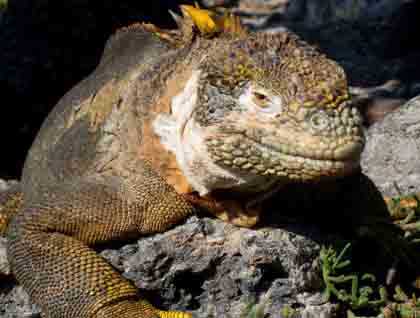Around 6:00 a.m. we arrived at South Plazas Island and the National Geographic Islander dropped its anchor. I woke up happy and ready to continue our expedition around these enchanted islands. Plazas is a beautiful island - quite small and located on the eastern side of Santa Cruz, its home of a healthy population of Galapagos land iguanas. Just few meters from the landing jetty we observed many of them warming their bodies on the rocks, making their nests or feeding on cactus, while along the shallows a great number of playful sea lions jumped and swam under the attentive sight of a big male.
According to scientists the Iguanas found in Galapagos are probably descendants of the green iguana living in Central America, they arrived here on tree-trunks and evolved in isolation. At Plazas you find both marine and land iguanas, and sometimes they interbreed each other and result in a hybrid iguana. Tree-like prickly pear cacti are the main territories for them, which are surrounded by Galapagos carpet-weed, with leaves that turn from green to yellow and from orange to red. The boulders made the walk uneven but interesting. We arrived at the steep banks where we observed a great number of birds such as red-billed tropicbirds, swallow-tailed gulls, shearwaters, Nazca and blue-footed boobies. At the end of the trail we found a Galapagos sea lion bachelor’s colony. The younger males waited for a chance to fight for a real territory, and the older ones seemed like they were telling fish tales.
In the afternoon we navigated to Santa Fe Island, our next destination. We passed by Gordon Rocks, an old tuff formation and one of the best scuba diving sites of the islands, which impressed us a lot. As soon we got to Santa Fe, our guests enjoyed some exciting snorkeling and kayaking along the shore, observing white-tipped reef sharks, sea turtles, sting rays, and a large number of colorful fish. After snorkeling we headed to the landing beach to observe the enigmatic Santa Fe land iguana, which is a paler color versus the land iguana we saw previously this morning. This species of iguana is endemic to this island, we observed some of them resting on the rocks basking their bodies with the last beams of sun of the day. The beach where we landed was crowded with sea lion pups and their mums feeding them. The trail at Santa Fe Island goes across a forest of palo-santo trees and giant opuntia cacti, and once inland we walked uphill and suddenly had an amazing view of the bay with its turquoise blue water.
Two of the best places to observe land iguanas in their natural habitat are South Plaza and Santa Fe Islands. And we enjoyed both. South Plaza was formed by lava up streaming from the bottom of the ocean while on the other hand, Santa Fe geologically is one of the oldest islands here, since volcanic rocks of about four million years old have been found. They are so different but both so amazing.
Around 6:00 p.m. the sun was ready to go bed. At the equator the sunset happens very fast, and when we headed back to the National Geographic Islander it was almost dark, leaving behind another beautiful day in this natural paradise which is a natural heritage site - so pristine, so outstanding, so unique.









